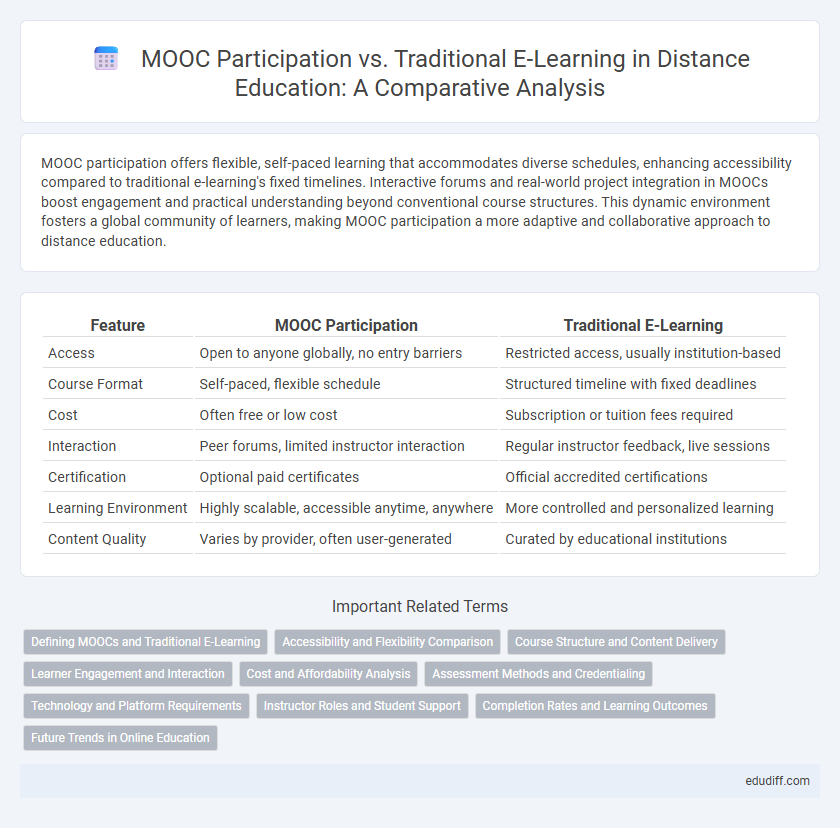MOOC participation offers flexible, self-paced learning that accommodates diverse schedules, enhancing accessibility compared to traditional e-learning's fixed timelines. Interactive forums and real-world project integration in MOOCs boost engagement and practical understanding beyond conventional course structures. This dynamic environment fosters a global community of learners, making MOOC participation a more adaptive and collaborative approach to distance education.
Table of Comparison
| Feature | MOOC Participation | Traditional E-Learning |
|---|---|---|
| Access | Open to anyone globally, no entry barriers | Restricted access, usually institution-based |
| Course Format | Self-paced, flexible schedule | Structured timeline with fixed deadlines |
| Cost | Often free or low cost | Subscription or tuition fees required |
| Interaction | Peer forums, limited instructor interaction | Regular instructor feedback, live sessions |
| Certification | Optional paid certificates | Official accredited certifications |
| Learning Environment | Highly scalable, accessible anytime, anywhere | More controlled and personalized learning |
| Content Quality | Varies by provider, often user-generated | Curated by educational institutions |
Defining MOOCs and Traditional E-Learning
Massive Open Online Courses (MOOCs) are large-scale online courses designed for unlimited participation and open access via the web, offering interactive user forums and peer-to-peer learning. Traditional e-learning typically involves structured, enrollment-based courses delivered through Learning Management Systems (LMS), often with a cohort of students and instructor-led sessions. MOOCs emphasize scalability and accessibility, whereas traditional e-learning prioritizes personalized instruction and formal assessment within a controlled learning environment.
Accessibility and Flexibility Comparison
MOOC participation offers greater accessibility by removing geographical barriers and providing free or low-cost enrollment options compared to traditional e-learning, which often requires institutional registration and fees. Flexibility in MOOCs allows learners to access materials anytime and self-pace their studies, whereas traditional e-learning typically follows fixed schedules and structured timelines. This increased accessibility and flexibility make MOOCs a preferred choice for diverse, global learners seeking flexible education opportunities.
Course Structure and Content Delivery
MOOC participation emphasizes flexible course structures with modular content and self-paced learning, enhancing accessibility for diverse learners worldwide. Traditional e-learning often follows rigid schedules with instructor-led sessions and fixed timelines, supporting more structured and interactive engagement. Content delivery in MOOCs relies heavily on video lectures, quizzes, and peer assessments, while traditional e-learning integrates live webinars, discussion forums, and real-time feedback to facilitate deeper learner-instructor interaction.
Learner Engagement and Interaction
MOOC participation often results in higher learner engagement due to diverse interactive elements such as peer forums, quizzes, and live webinars, which foster collaborative learning beyond traditional boundaries. Traditional e-learning typically relies on structured, instructor-led modules that may limit spontaneous interaction but provide consistent, guided feedback. Enhanced interaction in MOOCs leverages large learner communities, increasing motivation through shared experiences and dynamic content updates.
Cost and Affordability Analysis
Massive Open Online Courses (MOOCs) offer a cost-effective alternative to traditional e-learning by eliminating expenses related to physical infrastructure and printed materials. Enrollment fees for MOOCs are typically lower or free, drastically improving affordability for a global audience. This scalability reduces per-student costs, making MOOCs a financially viable option for budget-conscious learners and institutions alike.
Assessment Methods and Credentialing
MOOC participation often relies on automated quizzes, peer assessments, and project-based evaluations to provide scalable and immediate feedback, contrasting with traditional e-learning's reliance on instructor-graded assignments and proctored exams. Credentialing in MOOCs frequently involves digital certificates and badges, offering flexible, cost-effective recognition, whereas traditional e-learning typically provides formal accredited diplomas and transcripts. The scalability and accessibility of MOOC assessments support mass enrollment, while traditional e-learning emphasizes rigorous, individualized evaluation for professional accreditation.
Technology and Platform Requirements
MOOC participation demands scalable cloud-based platforms capable of handling massive concurrent users, leveraging open-source technologies for flexibility and interoperability. Traditional e-learning often relies on proprietary Learning Management Systems (LMS) with limited user capacity and integration options. Advanced video streaming, AI-driven analytics, and mobile accessibility are critical technology features driving MOOC platforms' success in global learner engagement.
Instructor Roles and Student Support
MOOC participation relies heavily on automated systems and peer support, reducing direct instructor interaction compared to traditional e-learning environments where instructors provide personalized guidance and real-time feedback. In traditional e-learning, instructor roles include facilitating discussions, assessing progress, and offering tailored support, which enhances student engagement and learning outcomes. Student support in MOOCs is often scalable but less individualized, utilizing forums, AI tutors, and standardized resources to accommodate large, diverse populations.
Completion Rates and Learning Outcomes
MOOC participation often results in lower completion rates compared to traditional e-learning due to open enrollment and limited learner support. However, MOOCs provide accessible learning outcomes through flexible pacing and diverse course offerings that cater to a global audience. Traditional e-learning tends to generate higher retention and deeper understanding, driven by structured curricula and direct instructor engagement.
Future Trends in Online Education
MOOC participation is rapidly increasing, driven by accessibility and diverse course offerings, while traditional e-learning continues evolving with personalized learning paths and AI-driven analytics. Future trends point towards hybrid models combining MOOCs' scalability with traditional platforms' structured frameworks, enhancing learner engagement and skill acquisition. Integration of augmented reality and adaptive learning algorithms will further transform online education, making it more interactive and tailored to individual needs.
MOOC participation vs Traditional e-learning Infographic

 edudiff.com
edudiff.com